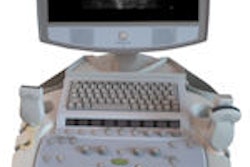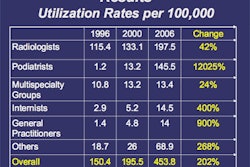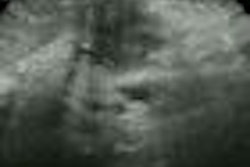NEW YORK CITY - Incorporating cine clips into routine ultrasound protocols can yield significant time savings and improvements in diagnostic confidence, according to research from the University of Arkansas for Medical Sciences in Little Rock.
"Introduction of cine clips into your routine ultrasound protocols results in significant time savings and we estimate that we could perform approximately 20-25% more examinations in any given day [using the new protocols]," said Dr. Ashley Bragg. "There is less rescan time [to confirm sonographer findings], more confident diagnoses, the sonographers report less repetitive stress disorders, and there is overall better communication between sonologists and clinicians."
She presented the research during a scientific session Saturday at the 2009 annual convention of the American Institute of Ultrasound in Medicine (AIUM).
The Arkansas researchers sought to evaluate the changes resulting from introducing cine clips into routine ultrasound protocols and to assess the effect of these changes on sonographer and sonologist behavior. They reviewed examinations of the neonatal head, complete abdomen, and complete pelvis, performed both one month before and one month after cine clips were added.
The institution's new neonatal head ultrasound protocol calls for cine clips to obtained in both the sagittal and coronal planes for visualization. Static images continue to be obtained for Doppler images and to document and measure any abnormalities, Bragg said.
In the complete abdomen study, static images are utilized to obtain measurements. Cine clips are obtained for the liver (both longitudinal and transverse planes), kidneys, and the gall bladder. A cine clip will also be obtained for any particular area of interest, she said.
As in the abdomen, complete pelvic exams include static images for measurements. Cine clips are also obtained in the uterus (both coronal and sagittal planes) and the ovaries or adnexa, she said.
The researchers reviewed 36 neonatal head, 60 complete abdomen, and 52 complete pelvic exams performed under the old protocol. They also reviewed 97 neonatal head, 56 complete abdomen, and 68 complete pelvic exams performed under the new protocol. The researchers then compared the results from each protocol to determine the impact on time savings and efficiency.
|
The researchers also surveyed sonographers and sonologists to gauge their opinion on the new protocols. Sonographers reported a decrease in repetitive stress disorders, less resistance to performing portable examinations, and fewer repeat studies. As for sonologists, survey responses included easier distinction between artifacts and true findings, less rescan time to confirm sonographer findings, easier communication with clinicians, and, overall, more confidence in diagnosis, Bragg said.
Some disadvantages of switching to the cine clip protocol could include a potential decrease in resident scanning time and an increase in storage requirements.
Under the new protocols, the average exam size for a neonatal head is 327.2 MB, up from 16.1 MB in the old protocol. The new complete abdomen scan had an average size of 264.3 MB (up from 19.2 MB), and the complete pelvic exam had a new average size of 177.1 MB (up from 16.2 MB).
"It's important to note that these numbers are the numbers required to obtain the images, but these files can be compressed and actually stored in a smaller size," she said.
Also, some PACS may require an upgrade to be able to accommodate cine clips, she said.
By Erik L. Ridley
AuntMinnie.com staff writer
April 8, 2009
Related Reading
Future of ultrasound will require technology, educational gains, April 4, 2009
Ultrasound can boost imaging use in developing countries, November 21, 2008
3D ultrasound can improve life for sonographers, save money, March 18, 2008
Job survey shows growing sonographer demand, February 28, 2008
Keeping sonographers by improving working conditions, July 5, 2007
Copyright © 2009 AuntMinnie.com



















